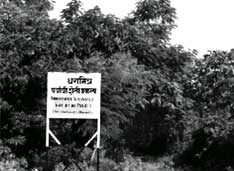Solutions forever
 debate and discussion, dialogue and the spirit of inquiry. These are the factors that are ushering in a gradual change in Saidapur village in Wardha district. The change is all about a new lifestyle that is kinder on the environment and the pocket.
debate and discussion, dialogue and the spirit of inquiry. These are the factors that are ushering in a gradual change in Saidapur village in Wardha district. The change is all about a new lifestyle that is kinder on the environment and the pocket.
Motivated by Dharamitra, a Wardha-based non-governmental organisation ( ngo ) three years ago, the villagers organised a study circle for farmers and initiated a dialogue among themselves and with representatives of the ngo . "It helped us understand many things that concern us, mainly issues related to the possibility of increasing agricultural production without any adverse environmental impact," says Sahebrao Chore, president of the gram sabha (the village assembly). The sabha has all 300 residents as its members and the study circle is its 'intellectual wing'. "We share a common concern.Like the villagers, I am also interested in making farming self-sustainable. But we do not believe in offering a standard package to the farmers," says Tarak Kate, secretary, Dharamitra. Kate is a botanist by profession and was formerly a joint director of the Wardha-based Centre of Science for Villages. He has been practising biodiversified agriculture and tuning it to the needs of the marginal farmer. He received the Ashoka Fellowship in 1993 for the same.
The initial discussions concentrated on cotton which is the village's main cash crop. It was found that productivity could be doubled with the use of chemical fertilisers, high-yielding seeds and pesticides, but input costs soared simultaneously and this reduced the overall profit margin. The regular yield of 150 kg per acre (0.47 ha), jumped to 300 kg when these inputs were employed. Following such massive gains, the farmer could earn Rs 3,000 per acre but not before bearing an input cost of Rs 2,000. Using traditional methods, the farmer might get only Rs 1,500 but in this case, his input cost would be virtually zero.
"So there was the need to increase the productivity modestly without hiking the input costs," says Kate. And the solution for this came from the farmers themselves. After a visit to a pilot organic farm (run by the Maharashtra state government) in Wardha, the farmers were only partially impressed. This was because the pilot farm had irrigation facilities, while the farms at Saidapur had none. Clearly, the farmers of Saidapur had to think of methods to conserve soil and water.
Three farmers whom Kate calls "technology leaders", came forward and adopted the techniques of contour bunding and gully plugging. In the course of just one season, the cotton yield of Devram Atra's (one of the pioneers) 0.2-ha-field leaped from 50 kg to 300 kg. Seeing the encouraging results obtained from the farms of the "technology leaders", others followed suit.
Another meeting of the gram sabha was called to discuss the results of contour bunding and gully plugging. Farmers realised that the techniques had prevented waterlogging in the field and also helped the soil retain moisture for a long period of time. The women of the area found certain advantages too. According to Meethabai Bude, president of the mahila mandal (a welfare group for women), "The contours divided big farms into several smaller ones and this not only reduced the monotony of the de-weeding operation but even made it a bit enjoyable."
A similar discussion on fertilisers and pesticides helped change the villagers' approach towards these inputs. Many farmers opted for organic manures once they realised the wastefulness of costly fertilisers. "Today, the use of chemical fertilisers has almost stopped in the village," claims Janardan Chore, a villager.
Dharamitra has also gained from the experience. Kate has learned about an indigenous concoction used as a pesticide by the villagers. The pesticide is made from 500 gm of crushed garlic mixed with kerosene, 100 gm of red chilli, some detergent powder and water. After soaking the mixture overnight, 100 ml of the potion is mixed with 15 lt of water. "When sprayed, the concoction is a deadly weapon against many insects and pests," says Gangadhar Masram, a villager known for his scientific bent of mind.
However, Saidapur is currently a monoculture region. After each crop, the farmer has to prepare the field and apply a number of inputs to replenish the nutrients lost by the soil. Attempts are also being made by Kate to make farming a perennial activity.
One can get a better idea of the general direction in which the people's efforts are moving if one takes a trip around Kate's own farm. His one-ha-field wears a rather unkempt look, being full of weeds. But a closer examination reveals that this small farm produces almost everything needed by a family of five. While a 0.4-ha-portion yields as many as six varieties of foodgrains - wheat, paddy, sorghum, lentils, maize and barley - another 0.4-ha-field is full of different kinds of fruits and vegetables. Kate has planted about 1,000 teak saplings in yet another corner. The boundaries are fenced with trees that yield fuel wood. A variety of weeds and grass comprise feed for his cows. Kate is also involved in mushroom cultivation and sericulture. A small fish pond and poultry farm complete the picture.
The farmers of Saidapur are quite impressed by Kate's concept of farming, of producing the biomass needed, themselves. "I am going to introduce earthworms in my field," declares Devaram Agam. Echoes Chandrakala Chore, "Now I will not clean my field of weeds and will plant fruit trees while sowing gram during the rabi season."
